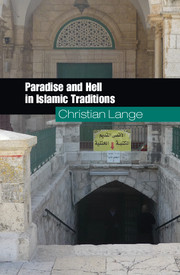Book contents
- Frontmatter
- Dedication
- Contents
- List of Figures
- List of Table and Charts
- Acknowledgements
- List of Abbreviations
- Note on Dates, Citation, Translations, and Transliteration
- Introduction
- Part I Textual Foundations: Narrating the Otherworld
- Part II Discourses and Practices: Debating the Otherworld
- 5 The Otherworld Contested: Cosmology, Soteriology, and Ontology in Sunni Theology and Philosophy
- 6 Otherworlds Apart: Shiʿi Visions of Paradise and Hell
- 7 The Otherworld Within: Paradise and Hell in Islamic Mysticism
- 8 Eschatology Now: Paradise and Hell in Muslim Topography, Architecture, and Ritual
- Epilogue
- Primary Sources
- Secondary Sources
- Index of Names
- Index of Terms
7 - The Otherworld Within: Paradise and Hell in Islamic Mysticism
from Part II - Discourses and Practices: Debating the Otherworld
Published online by Cambridge University Press: 05 December 2015
- Frontmatter
- Dedication
- Contents
- List of Figures
- List of Table and Charts
- Acknowledgements
- List of Abbreviations
- Note on Dates, Citation, Translations, and Transliteration
- Introduction
- Part I Textual Foundations: Narrating the Otherworld
- Part II Discourses and Practices: Debating the Otherworld
- 5 The Otherworld Contested: Cosmology, Soteriology, and Ontology in Sunni Theology and Philosophy
- 6 Otherworlds Apart: Shiʿi Visions of Paradise and Hell
- 7 The Otherworld Within: Paradise and Hell in Islamic Mysticism
- 8 Eschatology Now: Paradise and Hell in Muslim Topography, Architecture, and Ritual
- Epilogue
- Primary Sources
- Secondary Sources
- Index of Names
- Index of Terms
Summary
Asceticism and mysticism were part of Islam from its inception, as the Qurʾān gives rise to a vocabulary of renunciation and religious experience. As we saw in Chapter 1, the Qurʾān is a text pregnant with eschatological ideas, which it frames in terms that, if not fully mystical, are conducive towards conceiving this world and the otherworld as a unity, rather than as ontologically separate realms. In the gradual unfolding of what later came to be referred to by the umbrella term Sufism (taṣawwuf), the relationship between this world and the otherworld occupied centre stage. One should note at the outset, however, that there is a remarkable historical diversity of Sufi attitudes towards the otherworld. By charting a typology of these attitudes, this chapter seeks to trace how the Sufis’ conceptualisations of the otherworld reflected and reinforced their understandings of human existence and of the moral and spiritual status of the present world. Concomitantly, this chapter examines how Sufi thinkers described the nature, function, and ultimate value of the otherworld. What, in Sufi thought, is the relevance of belief in the two otherworldly abodes, and how is one to picture them? What constitutes felicity in paradise and misery in hell?
Fear and Longing in Early Sufism
In the collections of sayings attributed to the renunciants and mystics of the formative period of Sufism (third-sixth/ninth-twelfth centuries), one can identify four noticeable attitudes towards paradise and hell: fear of the otherworld; hope and longing for the otherworld; and dismissal of the otherworld, of which there is a cold (or “sober”) and a hot (or “intoxicated”) variant. These four basic attitudes do not follow upon one another in a neat chronological order. Rather, they overlap, sometimes even within the thought of a single individual. While many of the fourth/tenth- and fifth/eleventh-century handbooks of Sufism, such as al-Sarrāj's (d. 378/988) Book of Flashes (K. al-Lumaʿ) or al-Kalābādhī's (d. ca. 384/994) Introduction to the Doctrines of the Sufi School (K. al-Taʿarruf li-madhhab ahl al-taṣawwuf), preserve traces of all four of them, they tend to privilege sober dismissal over other modes of experiencing the otherworld. This makes reconstruction of the developments of earlier times difficult and complicates attempts at periodisation.
- Type
- Chapter
- Information
- Paradise and Hell in Islamic Traditions , pp. 219 - 244Publisher: Cambridge University PressPrint publication year: 2015

